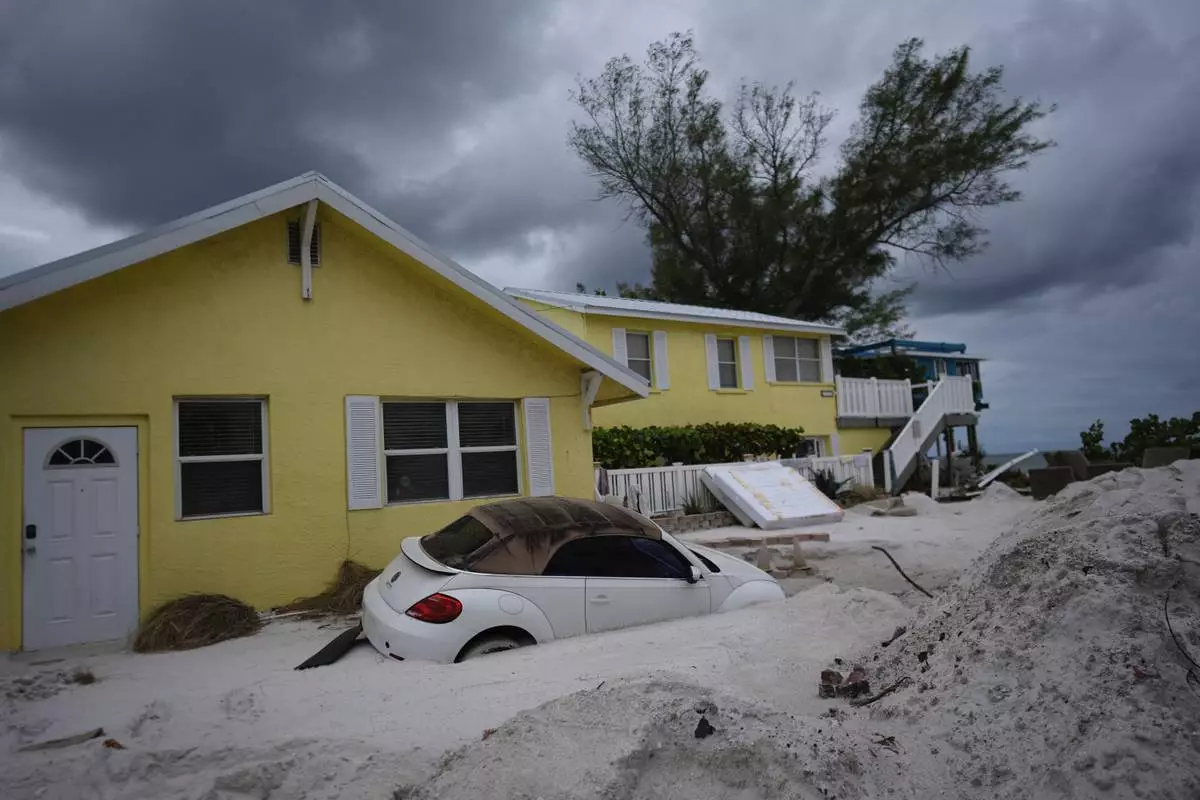ROME (AP) — Italian prosecutors on Saturday requested a six-year prison sentence for right-wing League leader Matteo Salvin i for his decision to prevent more than 100 migrants from landing in Italy when he was interior minister in 2019. If convicted Salvini could be barred from holding government office.
The prosecutors in the city of Palermo have accused Salvini — who’s currently deputy premier and transport minister in the right-wing government led by Giorgia Meloni — of alleged kidnapping for leaving a migrant rescue ship operated by charity Open Arms stranded at sea for 19 days.
During the 2019 standoff, some of the migrants threw themselves overboard in desperation as the captain pleaded for a safe, close port. The remaining 89 people onboard were eventually allowed to disembark in Lampedusa by a court order.
“I would do it all again: defending borders from illegal immigrants is not a crime,” Salvini said on his social media on Saturday.
His lawyer, Giulia Bongiorno, will make her defense statement in Palermo on Oct. 18, and a first sentence could come by the end of the month. A conviction – which in Italy is definitive only at the end of a three-stage judicial process -- could bar Salvini from holding government office.
Meloni and several ministers of her government expressed solidarity with the League leader, defending his decisions. Since she stepped into power in 2022, Meloni has pledged a crackdown on migration, aiming to deter would-be refugees from paying smugglers to make the dangerous Mediterranean crossing.
“It is incredible that a minister of the Italian Republic risks six years in prison for doing his job defending the nation’s borders, as required by the mandate received from its citizens,” the Italian premier wrote on X.
Salvini maintained a hard line on migration in his tenure as interior minister in the first government of Premier Giuseppe Conte, from 2018-2019.
He imposed a “closed ports” policy under which Italy refused entry to charity ships that rescued migrants in distress across the Mediterranean and repeatedly accused humanitarian organizations of effectively encouraging people smuggling.

FILE - Italian Deputy Prime Minister and Minister of Infrastructure and Transport Matteo Salvini attends a press conference during the G7 transportation ministers meeting in Milan, Italy, April 13, 2024. (AP Photo/Antonio Calanni, File)
WASHINGTON (AP) — Congress is allocating more than $100 billion in emergency aid designed to address extensive damage caused by disasters after this week's scramble to find consensus on a government spending bill.
The money comes after back-to-back hurricanes — Helene and Milton — slammed into the southeastern United States this fall, leaving havoc in their wake. But the money would go to much more than just those two storms under the bill signed Saturday by President Joe Biden that keeps the federal government funded through March 14.
The disaster funding looked set to pass earlier this week until President-elect Donald Trump issued new demands that tanked a compromise and threatened a pre-Christmas federal shutdown. A slimmed-down version cleared Congress early Saturday when Republicans abandoned Trump's core request.
Here's a look at what's in the bill for disaster relief and where the money will go:
The Federal Emergency Management Agency's disaster relief fund is essentially the country's checkbook for emergencies. Out of it, the government reimburses states and local governments for things such as removing debris accumulated after hurricanes or overtime costs for firefighters and police who work during disasters.
It also includes money for individual residents, ranging from the $750 payments that disaster survivors can get to $42,500 that some uninsured homeowners can receive to help them rebuild.
Esther Manheimer, mayor of Asheville, the largest city in the North Carolina mountains that was hard hit by Helene, said city officials were pleased to see th additional disaster dollars.
It’s only been four weeks since Asheville residents could drink from and bathe in the water coming out of their faucets. Some businesses in western North Carolina have shuttered permanently or are struggling to survive, and well over 200 roads in the region remain closed.
In a statement earlier in the week, Manheimer emphasized that it was still going to be a long recovery and that "already we see the long-term economic, budgetary and employment impact Helene left in her wake.”
The disaster relief fund was nearly running on fumes after Helene and Milton. FEMA Administrator Deanne Criswell warned during a Senate hearing in November that the fund was down to $5 billion.
The Biden administration had asked Congress for about $40 billion for the relief fund but the bill eventually passed provides a lower amount, $29 billion.
It’s important to keep in mind that this isn’t the only money for the disaster relief fund, said Stan Gimont, a senior adviser for community recovery at Hagerty Consulting. He used to run the community development block grant program at the Department of Housing and Urban Development.
More money can and likely will be designated to the fund later when Congress does a full-year appropriation, he said.
There's also about $21 billion in disaster assistance to help farmers.
North Carolina Agriculture Commissioner Steve Troxler said earlier this week that he was pleased by the agricultural aid but that the state has a lot of specialty crops such as sweet potatoes and Christmas trees that are generally not covered by federal programs. He said he will have to wait and see what specifically ends up being covered.
“We are still evaluating the bill as there are a lot of nuances in it. The devil is in the details," he said.
Other money will go toward rebuilding damaged roads and highways ($8 billion), while more money (about $12 billion) would go toward helping communities recover through HUD grants.
The block grant money is one of the key funds for homeowners who don’t have insurance or enough insurance to recover from disasters.
There’s also $2.2 billion for low-interest loans for businesses, nonprofits and homeowners trying to rebuild after a disaster.
But the money doesn't go just toward local residents.
For example, there's money for the military to address damage from hurricanes and typhoons and for a new hurricane hunter — the planes used to research hurricanes — and funds to help NASA rebuild hurricane-damaged facilities.
No. The money goes to cover more than those two disasters.
Some of the money is specifically earmarked for certain projects such as $1.5 billion designated for assistance after the largest wildfire in New Mexico’s recorded history — the Hermit’s Peak/Calf Canyon fire — and the rebuilding of the Francis Scott Key Bridge in Baltimore.
But a lot of the money also goes more generally toward major disasters that happened in recent years.
The types of disasters covered in the legislation include droughts, wildfires, hurricanes, floods, derechos, and smoke exposure.
Gimont points out that disaster recovery can take a long time so the country is both paying for disasters that happened previously while it prepares for events that will happen in the future.
Take the massive Maui fire, for instance. It decimated the Hawaiian town of Lahaina last year, but Gimont said just the cleanup itself extended into late summer 2024.
Loller reported from Nashville, Tennessee.

FILE- North Carolina Gov. Roy Cooper, right, and Deanne Criswell, Administrator of the U.S. Federal Emergency Management Agency, await the arrival of Democratic presidential nominee Vice President Kamala Harris for a briefing on the damage from Hurricane Helene, at Charlotte Douglas International Airport, in Charlotte, N.C., Oct. 5, 2024. (AP Photo/Chris Carlson, File)

FILE - Michael Vierra looks at his house after it was destroyed by a wildfire, in Lahaina, Hawaii, Sept. 26, 2023. Authorities in Maui strongly encouraged homeowners to wear protective gear provided by nonprofit groups when visiting their properties to protect against asbestos, lead and other toxic remains of the wildfire. (AP Photo/Mengshin Lin, File)

FILE - Homes consumed in wildfires are seen in Lahaina, Maui, Hawaii, Aug. 16, 2023. (AP Photo/Jae C. Hong, File)

FILE - As Hurricane Milton approaches, a car sits half-buried in sand in Bradenton Beach, Fla., in the aftermath of Hurricane Helene, Oct. 8, 2024. (AP Photo/Rebecca Blackwell, File)

FILE - This photo provided by the North Carolina Department of Transportation shows the collapsed eastbound lane of I-40 into the Pigeon River in North Carolina near the Tennessee border, Sept. 28, 2024. (N.C. Department of Transportation via AP, File)

FILE - A man walks near a flooded area near the Swannanoa river, effects from Hurricane Helene , Friday, Sept. 27, 2024, in Asheville, N.C. (AP Photo/Erik Verduzco, File)

FILE - Ben Phillips, left, and his wife Becca Phillips scrape mud out of their living room in the aftermath of Hurricane Helene, in Marshall, N.C., Oct. 1, 2024. (AP Photo/Jeff Roberson, File)

FILE - Damage from Hurricane Helene near Asheville, N.C., is seen during an aerial tour for President Joe Biden, Oct. 2, 2024. (AP Photo/Susan Walsh, File)


















